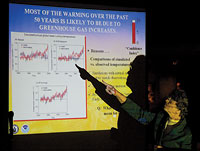As the world melts

photo by Jonathan Welch
|
Deputy Director of the Asheville-based National Climatic Data Center Sharon LeDuc delivered a lecture on climate change at Warren Wilson College on Oct. 17 to provide an overview of current scientific understanding on the topic. NCDC, which operates out of the Federal Building on Patton Avenue, archives data from the National Oceanic and Atmospheric Administration Satellite and Information Service and falls under the U.S. Department of Commerce. NCDC serves as the “repository for weather information for the entire history of the world,” according to LeDuc, and a few scientists employed there also serve on the Intergovernmental Panel on Climate Change, an international body of scientists working to understand global warming.
“The vast majority of scientific viewpoint believes that human-caused global warming has occurred,” LeDuc stated during her lecture.
Based on data from by the U.S. Department of Energy, there has been a 36 percent increase in carbon-dioxide emissions in the earth’s atmosphere since 1900, illustrated on line graphs measuring greenhouse-gas concentrations that swoop dramatically upward at the tail end of a 1,000-year timeline. There is a high “confidence index” within the scientific community that these increases are caused by human activity and are trapping increasingly more heat in the earth’s atmosphere, she said.
Coinciding with these higher greenhouse-gas concentrations are increases in global temperature and sea level, according to slides presented by LeDuc. “The global temperature has gone up from 0.7 to 1.4 degrees over the past 100 years,” she said. Also: “The glaciers have retreated, there’s been a reduction in sea ice, the snow cover has decreased, the growing season has lengthened, the sea level has increased by 4 to 8 inches since the 19th century, and the lake and river ice have shortened seasons.”
LeDuc addressed several common misperceptions about climate change, including one that global cooling, not warming, is actually occurring based on satellite-data records. Thought to be true several years ago, the theory got the attention of the Climate Change Science Program, formed recently under the Bush administration. “The first report that they came out with just this year addressed this discrepancy. … And it turned out that there needed to be some calibration to the satellite studies.” Since the report, there is no longer a disagreement among scientists on that point, she says.
Stabilizing emissions “will not have an effect for a long time,” LeDuc stressed. An atmospheric buildup of greenhouse gases is likely to continue trapping heat, even if action is taken to limit the amount of carbon dioxide routinely discharged into the atmosphere from sources like coal-fired power plants. A range of possible future scenarios, from stabilizing emissions to taking no action, suggests a global temperature increase ranging from 2.5 to 10 degrees Fahrenheit by 2100, based on climate models. This would exceed the natural changes over the past 10,000 years.
A variety of geophysical processes may be triggered due to changing climate conditions. As permafrost melts, methane — a potent greenhouse gas — will be released in quantity, and melting ice sheets will cause more heat to be absorbed by the earth’s surface rather than reflected by white sheets of ice, she said. Increases in drought and heavy precipitation are predicted, as is a shift in ocean circulation, which could bring any number of unexpected changes. “We are in a new regime of climate perturbation,” LeDuc said. “We are on our way to concentrations of greenhouse gases larger than have been observed over the past 500,000 years or more.”
Tours of the National Climatic Data Center are open to the public. For more information, call 271-4203.



Before you comment
The comments section is here to provide a platform for civil dialogue on the issues we face together as a local community. Xpress is committed to offering this platform for all voices, but when the tone of the discussion gets nasty or strays off topic, we believe many people choose not to participate. Xpress editors are determined to moderate comments to ensure a constructive interchange is maintained. All comments judged not to be in keeping with the spirit of civil discourse will be removed and repeat violators will be banned. See here for our terms of service. Thank you for being part of this effort to promote respectful discussion.